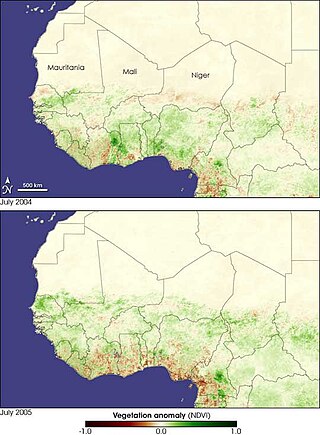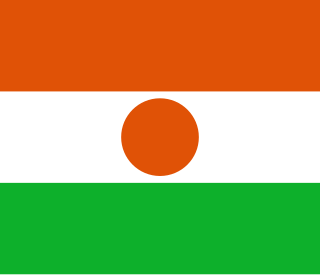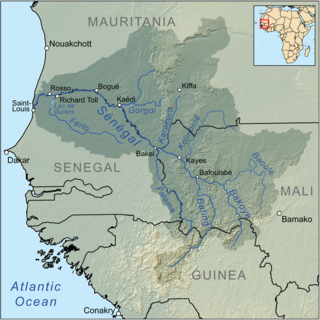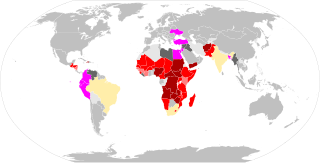This article may require cleanup to meet Wikipedia's quality standards. The specific problem is: tone, style.(December 2018) |

Food insecurity in Niger is a growing concern, with more than 1.5 million people affected in the year 2017. [1]
This article may require cleanup to meet Wikipedia's quality standards. The specific problem is: tone, style.(December 2018) |

Food insecurity in Niger is a growing concern, with more than 1.5 million people affected in the year 2017. [1]
Some of the largest contributing factors to the low level of food security throughout Niger include high priced essential food, susceptible crops, drought and soil infertility. [2] The United Nations estimates that 3.4 million Nigeriens are suffering from food insecurity with around half the population of children under the age of 5 being classified as chronically malnourished. [3] Large contributing factors to this problem are inadequate agricultural production and the limited financial resources that the government of Niger has. [1] Areas of the country such as Zinder, Maradi, Tillabéri, Tahoua, and Dosso are categorized as "high risk" livelihood zones; these regions all have experienced unpredictable rain and less access to food. [4] These are also some of the areas where food insecurity is the most prevalent due to the vulnerable state of the agro-pastoral regions. [5]
In 2017 Niger received a 29 on the Global Food Security Index; placing them in 110 out 113 countries. [6] Despite foreign intervention, poor households in Niger are desperate to maintain their current food consumption levels; resorting to migration, borrowing and sale of livestock. [4] This presents additional problems for these families; current exchange rates discourage selling of livestock from Niger to Nigeria which represents the main target market. [4]
In addition to unfavorable markets, Niger is susceptible to food shortages due to climate changes. During seasons of poor rainfall, it is estimated that nearly 30 percent of the population are unable to meet their food needs. [1] In 2012 it was estimated that a population of around 1.3 million people were in need of immediate assistance due to food insecurity as a direct result of unpredictable rain and sub-par agricultural yield. [7] The UN has identified 1.4 million people in need of food and 1.7 million people who need nutrition support countrywide. [8] Poor rainfall has also affected the amount of land dedicated to grow staple agriculture such as millet; which have decline from 25 percent to 12 percent of the country since the 1960s. [9] Niger struggles to produce and supply food during unfavorable climate conditions which contributes to the population in Niger who suffer from food insecurity. In addition to dwindling land resources, food prices are also rising rapidly; the price of staple grains doubled in 2011, leaving many families in Niger unable to afford them. [7] It is predicted that by the beginning of 2019 many susceptible populations throughout the Diffa region will experience Stressed and Crisis levels of food insecurity based on the criteria outlined in the IPC. [10] Some of the food that Nigeriens do have access to is of lower quality. With diets poor in necessary nutrients, illnesses and diseases become more prevalent. Around 73 percent of children under 5, as well as, 46 percent of women who are of childbearing age are anemic due to diets low in vitamins and essential minerals. [1]
According to the Demographic and Health Survey the leading causes of child mortality rates are malaria at 27 percent, cough and cold at 19 percent, pneumonia at 11 percent and diarrhea at 10 percent. [11] There is an inversely proportional correlated trend of food intake with diseases such as malaria, hepatitis, cholera and measles due to weakened immune systems associated with inadequate food intake. [5] Another notable factor is the actual composition of Niger population. A substantial amount of the entire population is under the age of 15. [11] Niger's high fertility rates are a result of unbridled population growth, which increases the difficulty of developing the country. [11]
The inconsistent rainfall and low access to quality meals that has affected Niger within recent years is not the only contributing factor to the rate of food insecurity. Political conflict and border security also pose a significant threat to food security. Violence such as the Boko Haram crisis, displaced thousands of Nigeriens near the Lake Chad Basin while at the same time Niger is exposed to an influx of refugees from Mali and Nigeria. [10] Resulting in a larger population competing for dwindling resources such as food and arable land. The World Food Programme estimates that in 2017 half the population in the Diffa region is in need of humanitarian assistance with about 308,000 people who are considered food insecure. [12] Political conflicts and violence in Northern Nigeria has also made its way into Niger; adding to the food insecurity problems as well as endangering local communities. [1] These conflicts disrupted activities essential for livelihood, agriculture and trade throughout southern regions in Niger. [8]
In areas where violence is especially prevalent such as the northern area of Nigeria there are a few reports of humanitarian aid workers being executed. [13] These incidents can often complicate future aid programs for these target areas. As a result of the violence, more than half a million children near and throughout the Lake Chad Basin area suffer from food insecurity and are considered malnourished. [14] Households in the Tillaberi and Diffa regions typically have lower access to food compared to the rest of the country. [15]
With the support of various foreign institutions such as the World Bank, there are plans addressing the growing concern, including a $20 monthly payment plan to women in high risk homes that will allow them to buy more food and improve their food security. [16] These interventions are more long term; as very short-term solutions do not appear to solve any problems beyond the length of time that they are implemented. [16] The World Bank is not alone in their attempts to alleviate food insecurity in Niger; there is also the work being done by the World Food Programme.
One of the strategies pursued by the World Food Programme is community-based asset aid. [1] This encourages the production of land rehabilitation, specifically in regions that are extremely sensitive to climate conditions. [1] Members of the Mercy Corps organization were deployed at places prone to food insecurity in Niger in order to monitor food levels and malnutrition to reduce response time in the event of an emergency. [7] The USAID's Food for Peace office has contributed roughly $203.7 million between 2016 through 2018. [8] Other tactics being deployed in Niger involve the creation of short-term jobs, maintaining the health of local livestock and working with the general population to build more climate resistant communities. [7]
The UN 2018 Humanitarian Response Plan for Niger calls for $338 million; with a majority of that money targeted towards helping to provide food security and nutrition assistance across the country. [8] To reduce the levels of malnourishment observed, children considered malnourished are often treated with iron, folic acid and vitamin A systematically. [17] The World Food Programme states that in 2015 humanitarian assistance provided 200,000 children with school meals across 1,250 schools. [18]

The World Food Programme (WFP) is an international organization within the United Nations that provides food assistance worldwide. It is the world's largest humanitarian organization and the leading provider of school meals. Founded in 1961, WFP is headquartered in Rome and has offices in 87 countries. In 2023 it supported over 152 million people, and it is present in more than 120 countries and territories.

Diffa is one of the seven Regions of Niger, located in the southeast of the country. The capital of the region is Diffa.

The 2005–2006 Niger food crisis was a severe but localized food security crisis in the regions of northern Maradi, Tahoua, Tillabéri, and Zinder of Niger from 2005 to 2006. It was caused by an early end to the 2004 rains, desert locust damage to some pasture lands, high food prices, and chronic poverty. In the affected area, 2.4 million of 3.6 million people are considered highly vulnerable to food insecurity. An international assessment stated that, of these, over 800,000 face extreme food insecurity and another 800,000 in moderately insecure food situations are in need of aid.
Famine scales are metrics of food security going from entire populations with adequate food to full-scale famine. The word "famine" has highly emotive and political connotations and there has been extensive discussion among international relief agencies offering food aid as to its exact definition. For example, in 1998, although a full-scale famine had developed in southern Sudan, a disproportionate amount of donor food resources went to the Kosovo War. This ambiguity about whether or not a famine is occurring, and the lack of commonly agreed upon criteria by which to differentiate food insecurity has prompted renewed interest in offering precise definitions. As different levels of food insecurity demand different types of response, there have been various methods of famine measurement proposed to help agencies determine the appropriate response.

Malawi is one of the world's undeveloped countries and is ranked 170 out of 187 countries according to the 2010 Human Development Index. It has about 16 million people, 53% of whom live under the national poverty line and 90% of whom live on less than $2 per day.

The following outline is provided as an overview of and topical guide to Niger:
The Integrated Food Security Phase Classification (IPC), also known as IPC scale, is a tool for improving food security analysis and decision-making. It is a standardised scale that integrates food security, nutrition and livelihood information into a statement about the nature and severity of a crisis and implications for strategic response.

A large-scale, drought-induced famine occurred in Africa's Sahel region and many parts of the neighbouring Sénégal River Area from February to August 2010. It is one of many famines to have hit the region in recent times.

There were 735.1 million malnourished people in the world in 2022, a decrease of 58.3 million since 2005, despite the fact that the world already produces enough food to feed everyone and could feed more than that.

The Board for International Food and Agricultural Development (BIFAD) advises the United States Agency for International Development (USAID) on issues concerning agriculture, higher education in developing countries, and food insecurity. BIFAD was established and recognized by Title XII of the Foreign Assistance Act, and both the BIFAD board and Title XII recognize the critical role of U.S. land-grant institutions in food and agricultural security, domestically and abroad. BIFAD consists of seven board members appointed by the White House, four of whom must have been part of the US Academic community. The board's mission is to draw on the expertise and scientific knowledge of those in higher education to advise the US international assistance on the effect of domestic efforts to end food insecurity.
Since 2016, a food insecurity crisis has been ongoing in Yemen which began during the Yemeni civil war. The UN estimates that the war has caused an estimated 130,000 deaths from indirect causes which include lack of food, health services, and infrastructure as of December 2020. In 2018, Save the Children estimated that 85,000 children have died due to starvation in the three years prior. In May 2020, UNICEF described Yemen as "the largest humanitarian crisis in the world", and estimated that 80% of the population, over 24 million people, were in need of humanitarian assistance. In September 2022, the World Food Programme estimated that 17.4 million Yemenis struggled with food insecurity, and projected that number would increase to 19 million by the end of the year, describing this level of hunger as "unprecedented." The crisis is being compounded by an outbreak of cholera, which resulted in over 3000 deaths between 2015 and mid 2017. While the country is in crisis and multiple regions have been classified as being in IPC Phase 4, an actual classification of famine conditions was averted in 2018 and again in early 2019 due to international relief efforts. In January 2021, two out of 33 regions were classified as IPC 4 while 26 were classified as IPC 3.

In the early months of 2017, parts of South Sudan experienced a famine following several years of instability in the country's food supply caused by war and drought. The famine, largely focused in the northern part of the country, affected an estimated five million people. In May 2017, the famine was officially declared to have weakened to a state of severe food insecurity.
In Afghanistan, poverty is widespread in rural and urban areas. However, it has been estimated that poverty in Afghanistan is mainly concentrated in rural areas. It has been estimated that four out of five poor people live in rural areas. In these rural areas, families without enough access to adequate nutrition see many infants and children become stunted, malnourished, and die each year. The regions in Afghanistan where almost half of the inhabitants are poor are the eastern, northeastern, and west-central regions. According to the Afghan government's estimates, 42 percent of the Afghanistan's total population lives below the poverty line. Also, 20 percent of people living just above the poverty line are highly vulnerable to falling into poverty.
Poverty in Niger is widespread and enduring in one of the world's most impoverished countries. In 2015, the United Nations (UN) Human Development Index ranked Niger as the second least-developed of 188 countries. Additionally, in 2015 the Global Finance Magazine ranked Niger 7th among the twenty-three poorest countries in the world. Two out of three residents live below the poverty line and more than 40 percent of the population earn less than $1 a day. Civil war, terror, illness, disease, poverty and hunger plague Niger. Hunger is one of the most significant problems the population faces daily. With a national population of 19,899,120, 45.7% of this population live below the poverty line.

Chad currently suffers from widespread food insecurity. A majority of the population of Chad now suffers some form of malnutrition. 87% of its population lives below the poverty line. Because the country is arid, landlocked, and prone to droughts, many Chadians struggle to meet their daily nutritional needs. While international aid into the country has brought some relief, the situation in Chad remains severe due to broader famine in the Sahel region. The World Food Programme has declared a state of emergency in the region since early 2018, stating that, “...adding to the poverty, food insecurity and malnutrition which already affects [the nations of the Sahel] to varying degrees, drought, failed harvests and the high prices of staple foods have hastened the arrival of this year’s ‘lean season’ – the worst since 2014.” Malnutrition is high, especially among women and children, with a significant majority of all children in Chad suffering from some form of stunted growth or adverse health effects as a result. As such, health in Chad is greatly affected by lack of food. Food insecurity is a symptom of broader instability in Chad, which suffers from political, ethnic, and religious instability. These issues have contributed to long-term food insecurity in Chad.
Long term aid to those in need creates a fear of having those provided with aid falling into the dependency theory. The rationale is that those who are benefiting will lose motivation to improve their lives on their own. Some may even work to worsen their condition in order to qualify for the aid. Additionally, one argument is that peripheral countries, such as Ethiopia, will not move out of needing aid because of the advanced economy's control. On average, Ethiopia has received 700,000 tons of food aid per year for the past 15 years. In rural Ethiopia, food aid has been provided for over three decades.
The state of food security is a heavily scrutinized issue in the United Republic of Tanzania. Agriculture accounts for almost one-third of the nation's GDP. It is an aspect of Tanzania that although obstructed by many internal and external factors, is continually worked on by outside forces and the nation itself.
This article lists events from the year 2020 in Niger.

During the COVID-19 pandemic, food insecurity intensified in many places. In the second quarter of 2020, there were multiple warnings of famine later in the year. In an early report, the Nongovernmental Organization (NGO) Oxfam-International talks about "economic devastation" while the lead-author of the UNU-WIDER report compared COVID-19 to a "poverty tsunami". Others talk about "complete destitution", "unprecedented crisis", "natural disaster", "threat of catastrophic global famine". The decision of the WHO on 11 March 2020, to qualify COVID as a pandemic, that is "an epidemic occurring worldwide, or over a very wide area, crossing international boundaries and usually affecting a large number of people" also contributed to building this global-scale disaster narrative.
{{cite web}}: Missing or empty |title= (help){{cite web}}: CS1 maint: archived copy as title (link){{cite web}}: Missing or empty |title= (help){{cite web}}: Missing or empty |title= (help){{cite web}}: Missing or empty |title= (help)